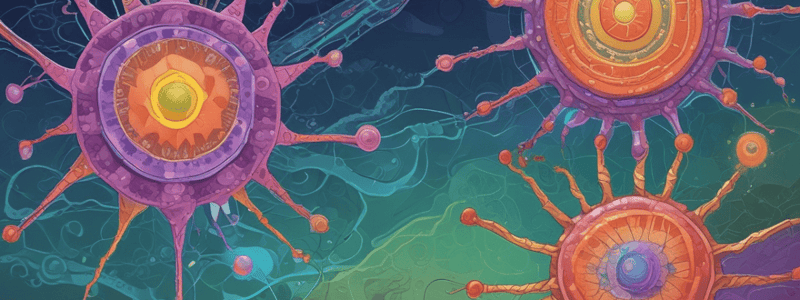Podcast
Questions and Answers
What is the result of inserting the 'membrane attack complex' into the cell membrane of target cells?
What is the result of inserting the 'membrane attack complex' into the cell membrane of target cells?
- Release of histamine
- Activation of mast cells
- Disruption of the cell membrane leading to lysis (correct)
- Phagocytosis of cells
What role does C3b play in the immune response?
What role does C3b play in the immune response?
- Initiates the classical pathway of complement activation
- Attracts neutrophils to the site of inflammation
- Acts as an anaphylatoxin
- Coats cells and antigen-antibody complexes for better phagocytosis (correct)
Which components are known as 'anaphylatoxins'?
Which components are known as 'anaphylatoxins'?
- C3b
- C5b, C6, C7
- C1, C2, C4
- C3a, C4a, C5a (correct)
Which complement component specifically activates and attracts neutrophils and macrophages?
Which complement component specifically activates and attracts neutrophils and macrophages?
Which pathway of complement activation bypasses C1, C4, and C2, starting directly with C3?
Which pathway of complement activation bypasses C1, C4, and C2, starting directly with C3?
Which of the following is responsible for promoting the inflammatory reaction by causing mast cell degranulation?
Which of the following is responsible for promoting the inflammatory reaction by causing mast cell degranulation?
Flashcards are hidden until you start studying
Study Notes
Biological Activities of the Complement System
-
Cell Lysis: The complement system can cause cell death by disrupting the cell membrane, allowing water and electrolytes to enter the cell, ultimately leading to cell lysis, often seen in bacterial cells, red blood cells, graft cells, or tumor cells.
-
Opsonization: Complement component C3b acts as an opsonin, enhancing phagocytosis of cells and antigen-antibody complexes.
Inflammatory Reactions
- Chemotaxis: C5a is a chemotactic agent, attracting neutrophils and macrophages to the site of inflammation.
- Anaphylatoxins: C3a, C4a, and C5a are anaphylatoxins, causing degranulation of mast cells and releasing histamine and other inflammatory mediators, promoting the inflammatory reaction.
Complement System Activation Pathways
- Classical Pathway: All components, starting with C1, are activated in this pathway.
- Alternative Pathway: C1, C4, and C2 are bypassed, and C3 is activated directly in this pathway.
- Lectin Pathway: All components, except C1, are activated in this pathway.
Studying That Suits You
Use AI to generate personalized quizzes and flashcards to suit your learning preferences.





